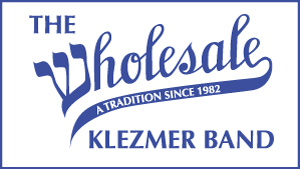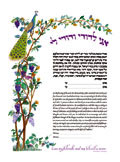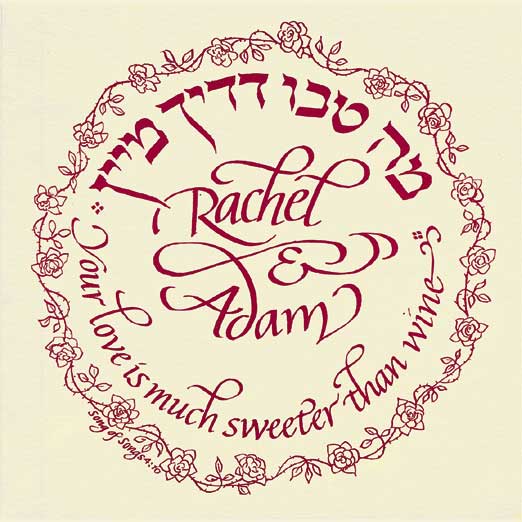
The Wholesale Klezmer Band
Guide
to Jewish Weddings
For information and bookings, call Yosl Kurland
at 413-624-3204 or e-mail us at wkb@ganeydn.com
 |
The Wholesale Klezmer BandGuide
|
|
For information and bookings, call Yosl Kurland |
"Your music was the soul of our wedding" |
Copyright © 1993-2013 by Yosl Kurland
Whether or not you are having a traditional Jewish wedding, the musical traditions brought to you by the Wholesale KIezmer Band can enhance the meaning, sense of community, and enjoyment of your special day. In planning your wedding, take advantage of our more than forty years' experience performing at hundreds of celebrations since our founding in 1982. We can help you choose music to match the mood you want to set for your ceremony, the kinds of traditional dances you would like us to play for and to lead, and if you like, to entertain with Yiddish folk and theater songs. What follows is a short guide to traditional weddings and wedding music. The Wholesale Klezmer Band can help you create a wedding as traditional or untraditional as you like. We will help you plan and carry out whichever elements or variations you would like to incorporate into your wedding. We will be happy to help you adapt traditional elements into more egalitarian or non-traditional styles.
Listen to some samples of our music on-line by clicking on these links or ask us to send you a demo copy of one of our CDs by calling Yosl (Joe) Kurland at 413-624-3204 or e-mail at wkb@ganeydn.com
|
|
At the khosns tish the main order of business is the signing of the ketubah, the marriage contract by the witnesses. Sometimes this is immediately preceded by the signing of the tnoyim, the engagement contract. This tradition comes from the idea that breaking an engagement contract, an agreement by the parents, is more of a dishonor to the families than getting a divorce, so the shorter the engagement, the better, even a ten-minute engagement. Following the tnoyim, the mothers of bride and groom break a plate. (Click on picture at left for more about this ceremony.
 |
|
Example of a ketubah, or Jewish wedding contract by Peggy Davis |
After the signing, the groom would traditionally attempt to deliver a droshe, a learned speech on Torah or Talmud. However, to avoid embarrassment, because not every groom is equally learned, the speech is always interrupted after a few words by the groom's friends who sing celebratory songs and get up to dance. On the groom's third attempt to begin the speech, the dancing overflows the room, and the groom is conducted to where the bride is seated for the badekn, the veiling. Members of the Wholesale Klezmer Band can get the singing and dancing going. Meanwhile, at the kale bazetsn, the seating of the bride, friends come and greet the bride. This is a time for quiet background music by members of the band with dancing, especially for the women, which can be led by our dance leader. This is also the time at which the badkhan, or wedding singer, might sing humorous verses warning the bride that her days of freedom are over, and teasing her about the "faults" of her husband to be. The groom's party arrives and the groom makes sure it is the right bride, reminding us of how Jacob was tricked into thinking he was marrying Rachel. He puts the veil over the bride's face and the band leads the guests to the khupe with a lively tune. Food is often served at the khosns tish and at the bazetsn.
|
|
For an egalitarian wedding, we can help you plan a way to combine the functions of the khosns tish and the bazetsn with appropriate music.
Music for the ceremony begins with processionals and ends with lively music at the very end. Some couples ask us to play particular musical selections or songs within the body of the ceremony. The two usual types of music chosen for the processionals are an old-style Eastern European khupe march or modern Israeli settings of passages from the Song of Songs. Ask your Wholesale Klezmer Band advisor to give you an idea of what the different tunes sound like. In a traditional wedding, the bride circles the groom seven times under the khupe. The music for this is in a slow rhythm known as a Roumanian hora. One old tradition is for the mothers of the bride and groom to guide the bride as she circles the groom, sometimes each holding a candle. In any case, the bride's mother should never be asked to hold the bride's train, as that puts her in a servant role, rather than a position of honor. In egalitarian weddings, the bride and groom may take turns circling each other.
|
The parts of a traditional khupe ceremony are the blessing over a cup of wine, the exchange of rings or other tokens, the recitation of the traditional consecration, reading of the ketubah by the rabbi or officiant, the rabbi's talk, and the seven blessings. The breaking of a glass marks the end of the ceremony and the band breaks into lively congratulatory music. The bride and groom go off to yikhud, to have time alone with each other. Guests may spontaneously begin dancing. The band plays until the guests leave the area for where the party takes place, or leads the guests to the party area.
The band usually plays background music while the party begins and hors d'ouevres are served. When the khosn and kale arrive from yikhud, lively dance music is played. Dancing may continue at this time or the meal may begin right away. Usually the main body of wedding dances occurs after the main course is served. If dinner is served in many courses, dancing can happen in shorter segments between courses. If you choose to have some Yiddish songs for entertainment, the best time is usually while people are finishing either their main course or dessert, before they are ready to get up and dance again.
|
According to tradition, it is a mitzve, a commandment, to entertain the bride and groom by dancing at their wedding. The description of traditional mitzve dances below can help you choose which ones you would like the Wholesale Klezmer Band to play for and lead at your wedding party.
The couple is lifted on chairs. It helps to plan in advance for people to do this who have been coached to know how: taller people in the front so the chair leans back, and the couple can have hands free and not have to hold on. The couple hold opposite ends of a tikhl, a kerchief, and "dance" with each other.
The assembled company take turns in the center of the circle, dancing to entertain the couple, who are seated on chairs. Honored guests such as parents can be called up first while the music is slower, and then others on a list, or whom you call up yourself with our wireless microphone. Please provide us with a list if you want us to call them up.
The father of the bride dances with his daughter holding a tikhl, and hands his end of the tikhl, to the groom, who will then hand it to others. Make your own variations, such as groom dancing with his mother. Our badkhn Yosl has written a Yiddish song with which to call family members to dance the "Kosher Tants" with the bride (and/or groom) that can be adapted for your list of honorees.
Dancers mime things that the couple should know how to do in their new life together. You might see lighting candles, making bread, shovelling snow, or shoulder massages.
The Broiges Tants, or dance of anger and reconciliation, is traditionally performed by the mothers of the bride and groom. Unless your family knows how to do it, we will be happy to perform the Broiges Tants for you, or teach it to the mothers. (See movie above)
The friends and families on the bride's side and the groom's side start separately and dance through each other's lines until the two communities are woven into one.
Those to be honored (traditionally the parents when the youngest child is married off, but choose whom you wish) are seated in the center of the circle. Guests dance around them, as sections of the circle take turns dancing to the center to kiss the honored people.
It is traditional for the guests to bring handmade or hand-painted masks, streamers, banners, costumes, props or any colorful aids to fulfillment of the mitzve, that one should dance to entertain the bride and groom at their wedding.
In addition to traditional Jewish dances, the Wholesale Klezmer Band plays Yiddish waltzes, polkas and Miserlu, a Greek-American dance often played at Jewish weddings. We will play folk music from other cultures on request as well.
|
|
In the old days, and in some communities to this day, a badkhn would sing to entertain the bride, groom and guests. Our badkhn, Yosl Kurland, can lead the singing and dancing at the khosn's tish, lead dancing during the reception, sing to the bride at the badekn, perform a broyges tants with our flautist, Peggy Davis, or teach it to the bride's and groom's mothers. He will sing special Yiddish wedding songs that heighten the emotions of the occasion with laughter and tears. He is also able to compose a special badkhones for you - usually in Yiddish and English so that everyone can understand the meaning of the words and also experience the flavor of the Yiddish language. For this he will need you to supply, as far in advance as possible, whatever information you can, especially amusing anecdotes, about yourselves, your families, how you met, how you got to know each other and how you decided to get married, how your families reacted, significant life experiences, etc. Writing personal badkhones involves an additional charge that depends on the length and complexity of the verses that we write for you. We can perform generic badkhones without additional cost. You may request to see examples of personalized badkhones that Yosl has written for couples at whose weddings we have performed.For more on badkhones and pictures of dances that Yosl taught at a wedding, please see his badkhan's blog.
|
The Wholesale Klezmer Band repertoire includes a wide variety of Yiddish songs. If you have seen us in concert you have seen how we perform them with explanations, visual aids, or humorous vocabulary lessons so that guests who do not understand Yiddish will understand what the songs are about. Although a wedding, bas mitzve or bar mitzve is your show, not ours, many of our customers ask us to perform songs for the entertainment of their guests. If you would like us to include a few Yiddish songs in our performance, we would be happy to discuss with you which types would be appropriate for your celebration.
The Wholesale Klezmer Band's simkhe advisors are happy to help you plan the way dance and entertainment fit into your simkhe. We are experienced in leading dancing for groups that are not familiar with Jewish traditions. We watch to see just how much dance leading is necessary, and whether the guests can dance without being led. Many couples who have a non-traditional or non-religious ceremony find that traditional dancing led by the Wholesale Klezmer Band provides just the Jewish cultural content they want for their wedding. Even couples neither of whom are Jewish have found these dances add spice and meaning to their weddings.
"We heard the Wholesale Klezmer play at a friend's Bat Mitzvah and from the moment the music started we knew that they would be perfect for our wedding. The band had the ability of being part of the party without overorganizing our guests. It was a nice blend of giving direction without being overbearing."
Judy Wolfman & Peter Larratt, Templeton, MA.
"Your music was the soul of our wedding. The guests were utterly delighted and I feel we really learned some thing from the Mitzvah dances! You guys are great!"
Debra Strick & Chuck Osgood, Belmont, MA.
" ...People loved your friendliness, enthusiasm and spirit. Many people appreciated your encouragements at breaking the ice and getting everyone to dance. I myself expecially liked that you showed us some traditional dances. We are grateful that you were there to help make this day unforgettable."
Jacqueline Lichtenberg, Putney, VT
For further information call: Yosl Kurland 413-624-3204
E-mail: wkb@ganeydn.com
Are You Thinking about Invitations? |
Are You Thinking about a Ketubah? |
|
 |
Wholesale Klezmer Band's flautist, Peggy Davis, is also a Hebrew calligrapher who designs beautiful, meaningful invitations and ketubot. Please have a look at samples of her work. |
 |
For more information about the Wholesale Klezmer Band
Gan Eydn Jewish Art and Music